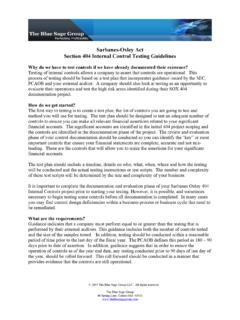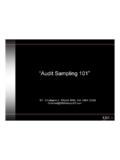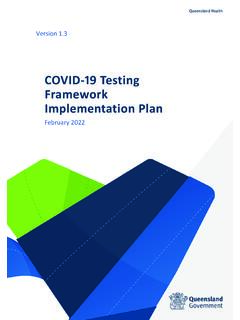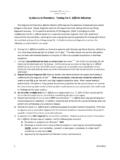Transcription of LABFACTS 27 ABO and Rh Blood Typing - Lab Florida
1 Requirementsfor goodlaboratorypracticeand COLAL aboratoryAccreditationprogramsare underlined. COLA--revised 7/97. COLA LABFACTS is a registered trademark of 27 DEFINITIONSA ntibody - A substance present in serum that isproduced as an immune response to a foreignsubstance introduced to the body (antigen).Antigen - A foreign substance that can produce animmune response (antibody).Agglutination - Clumping of particles (red bloodcells)Antihuman globulin - An antibody to human type and Rh factor - Blood type is anindividual s Blood group characterized as either A,B, O, or AB. Rh is the inheritable antigen measuredas either positive or negative. These antigens arepresent on the surface of the individual s red check cells - Red Blood cells that arecoated with immunoglobulin G (IgG) suspension - Red Blood cells from a patientthat are mixed with saline to obtain a 2 to 5 percentsolution (cherry color).
2 D control (Rh control ) - Bovine albumin, saline ormedia defined by the reagent manufacturer, whichis used as a negative control for Rh and Weak D(Du) D (Du) testing - testing that is done todetect a weak Rh Typing - A Blood Typing procedure wherebypatient red Blood cells are mixed with Anti-A andAnti-B Immune globulin - Concentrated solution ofAnti-D from human plasma which is given to preg-nant women who are Rh negative and who may becarrying and/or have delivered an Rh positive are several brands available, , - Proteins with known immuneresponse - The fluid remaining in separatedanticoagulated tubes that contains clotting Typing - A Blood Typing procedure wherepatient serum is mixed with reagent A cells andreagent B cells.
3 The results should be the oppositeof forward - The straw-colored fluid remaining whenblood is clotted. Serum does not contain any clot-ting and Rh Blood TypingINTRODUCTIONThe most commonly used immunohematology testis the ABO and Rh screen. ABO and Rh screeningdetermines the Blood type of the patient and can alsobe used to decide if a pregnant woman with Rhnegative Blood will need to receive Rh immune globu-lin ( , RhoGam). Rh immune globulin injectionhelps prevent the mother from forming antibodiesagainst the Rh antigen, a condition that may lead tohemolytic disease of the results of ABO/Rh testing are critical to patientcare. If a Blood type is incorrectly interpreted, thepatient may not receive the proper treatment.
4 Thefollowing information provides the essentials of ABO/Rh testing and appropriate quality control (QC) pro-cedures. However, it is not intended as a substitutefor adequate training in ABO/Rh COLLECTIONABO and Rh testing require both serum and red bloodcells; therefore, the specimen should be collected ina vacuum tube with no preservative (red topped tube).EDTA tubes (lavender topped) may also be using a red-topped tube, DO NOT USE GELSEPARATOR TUBES. The gel separator tube willput a layer of gel between the red Blood cells and theserum when centrifuged, making it very difficult toobtain the red Blood cells. The gel may also becomemixed with the red Blood cells, causing a negativereading to look the specimen as soon as possible.
5 If there is adelay in testing , properly store the specimen in PREPARATIONTest Tube Method - For red-top tubes, after collec-tion, allow the Blood to stand until a clot forms, thencentrifuge the specimen to separate the serum fromthe red Blood cells. After centrifugation, store theserum in a separate test tube and retain the red bloodcells in the original tube. Be sure to label all tubes withproper patient information to avoid confusing themwith other patient samples. For purple-top tubes,centrifuge the specimen to separate the plasma fromthe red Blood cells. The plasma may be stored in aRequirementsfor goodlaboratorypracticeand COLAL aboratoryAccreditationprogramsare underlined. COLA--revised 7/97. COLA LABFACTS is a registered trademark of 2727-2separate labeled tube like the red-topped specimen,or kept in the original tube to reduce separation, prepare a 2 to 5 percent red bloodcell suspension for testing .
6 There are several meth-ods that can be used for creating a cell suspensionpreparation. Each laboratory should establish its ownguidelines for the preparation of cell suggested procedures a disposable pipette, transfer ml (two drops) of the patients packed red bloodcells to a 10 x 75 mm test the tube with saline. Cover and the tube at 3,400 rpm for 30 seconds,then decant the estimate a 2 to 5 percent approximately 1 ml of saline will make a 3percent suspension, adding approximately mlof saline will make a 5 percent Method For PreparationOf 2 Percent 1 to 2 ml of Blood in large with saline and the remaining saline away fromthe red Blood Repeat washing (steps two and three) until super-natant is clear. The remaining red Blood cells arecalled a packed red Blood cell 10 ml of saline into a clean test ml (two drops) of the packed red Blood cellbutton to the 10 ml of saline.
7 After the red bloodcells settle to the bottom of the test tube, rinse thepipette with the surface layer of the saline toremove any red Blood cell Method For PreparationOf 5 Percent steps one to five from the 2 ml of packed red cell button to the 10 mlof saline and rinse pipette with the : For all methods of preparing a cell suspension,you can use your reverse grouping cells as a visualcheck on the concentration of your suspension, asthe concentration of the reagent red cells range from2 to 5 percent, as determined by the testing entails putting a sample of the cellsuspension in various reagents, centrifuging at aspecific speed for a specific period of time, and thengently shaking the tube. If there is any clumping ofblood cells, known as agglutination, the result for thatreagent is the manufacturer s instructions with eachreagent.
8 Also, when testing ABO/Rh controls or speci-men samples for ABO/Rh, the length of time the tubesare spun, as well as the speed of the centrifuge areimportant. If the tubes are spun for too long or too fastthe red Blood cell button may be too difficult todislodge from the test tube. Use gentle agitation whenresuspending the red Blood cell button from the the tube is agitated too hard, a weak positive resultcan be TestingABO testing should include both forward and reversetyping. Reverse Typing is a cross-check for forwardtyping. However, reverse Typing is not recommendedwhen Typing newborns and infants under the age of 4months since they have not developed the properantibodies necessary for the test to be Typing uses the patient s red Blood cells.
9 Allred Blood cells contain antigens that are specific tothe patient s Blood type. When antibody A (Anti-A) orantibody B (Anti-B) reagent is added to the patient sred Blood cells the antigens on the cells will cause thecells to react with the antibodies. For example, if thepatient has Blood type A, the patient s red Blood cellswill clump with antibody A (Anti-A), but will not showany clumping with antibody B (Anti-B). If the patienthas Blood type B, the patient s red Blood cells willclump with antibody B (Anti-B), and will not clumpwith antibody A (Anti-A). The forward Typing resultsare considered the patient Blood goodlaboratorypracticeand COLAL aboratoryAccreditationprogramsare underlined. COLA--revised 7/97. COLA LABFACTS is a registered trademark of 274testing must be done by the laboratory or a referencelaboratory.
10 It is imperative that all discrepancies beresolved before reporting the patient s Blood TestingAll patients are either Rh D positive or Rh D for the Rh D factor is done by using reagentAnti-D and patient red Blood cells. If the patient s redblood cells contain the D antigen (Rh D factor), therewill be agglutination when tested with Antibody D(Anti-D) and the patient is considered Rh D there is no agglutination of cells, then the patientis usually Rh D negative. See next section on WeakD (Du) each patient test, a patient control (Rh control )may be indicated depending on the recommenda-tion of the reagent manufacturer. The patient Rhcontrol consists of patient red Blood cells and acontrol substance. This control substance could bealbumin, saline or other material defined by themanufacturer.










